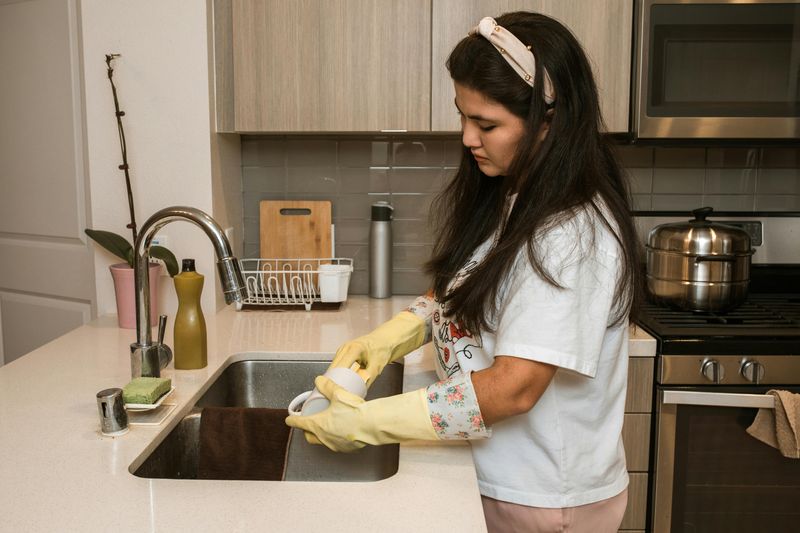Finding balance in our busy lives can feel impossible. The constant rush from one task to another leaves little room for peace and reflection. But small, consistent habits can create big changes in how we experience each day. These simple routines can help you build more mindfulness and balance without requiring huge lifestyle changes.
1. Morning Gratitude Practice
Before checking your phone, take two minutes to name three things you’re thankful for. This tiny habit rewires your brain to spot the good in your day before anything else.
Keep a notebook by your bed to jot these down, or simply think them through while stretching. Many people find that starting with gratitude creates a protective bubble around their mood.
The beauty of this practice is its simplicity – it requires no special equipment or training, just your attention for a moment before the day’s demands begin.
2. Five-Minute Breathing Breaks
Set reminders throughout your day to pause for deep breathing. These micro-breaks reset your nervous system and bring you back to the present moment when stress builds up.
Try the 4-7-8 method: breathe in for 4 counts, hold for 7, and exhale for 8. Your body responds almost immediately with lowered heart rate and blood pressure. Even one round makes a difference.
These breathing moments work anywhere – at your desk, in traffic, or while waiting in line – making them perfect for busy schedules when longer meditation feels impossible.
3. Nature Connection Ritual
Spend at least ten minutes outside every day, regardless of weather. This isn’t about exercise – it’s about using your senses to truly notice the natural world around you, even in urban environments.
Touch tree bark, listen for birds, smell the air after rain. Scientists have found that these brief nature interactions significantly lower stress hormones and improve mental clarity. The Japanese call this practice “forest bathing.”
Make it stick by connecting it to another daily habit – perhaps right after lunch or as a midday break when your energy naturally dips.
4. Single-Task Focus Periods
Pick one 20-minute period daily where you commit to doing just one thing with full attention. No multitasking allowed! This might feel strange at first in our notification-filled world.
Whether you’re eating lunch, washing dishes, or working on a project, bring your wandering mind back whenever it strays. The practice strengthens your focus muscle and reveals how rarely we give tasks our undivided attention.
Many people report that single-tasking actually saves time in the long run because you make fewer mistakes and remember more details when fully present.
5. Evening Brain Dump
Keep a notebook by your bed for a nightly thought-clearing session. Spend three minutes writing down everything on your mind – worries, to-dos, ideas – without judging or organizing the thoughts.
This simple practice prevents racing thoughts from keeping you awake. Your brain can relax knowing these thoughts are safely captured for tomorrow. Many therapists recommend this technique for anxiety management.
Don’t worry about grammar or making sense – this is just for you. The physical act of transferring thoughts from mind to paper creates mental space and signals to your body that it’s time to rest.
6. Mindful Meal Moments
Transform at least one meal daily into a sensory experience rather than a rushed necessity. Put away screens, sit down properly, and notice the colors, smells, textures, and flavors of your food.
Chew slowly and put your fork down between bites. You’ll likely enjoy your food more and feel satisfied with less. Your digestion improves too – our bodies process food better when we’re calm and present.
Start with just five mindful minutes if an entire meal feels overwhelming. Even this short practice can reset your relationship with eating and bring unexpected joy to this daily necessity.
7. Body Scan Reset
Take three minutes midday to check in with your physical self. Starting at your toes and moving upward, notice areas of tension without trying to change anything yet. Just becoming aware often leads to natural relaxation.
Are your shoulders hunched? Jaw clenched? Breathing shallow? These physical patterns reflect and reinforce stress states. The body scan helps catch stress before it escalates.
After noticing, take a few moments to adjust your posture, stretch tight areas, and deepen your breathing. This quick reset prevents tension from accumulating throughout the day and brings you back to the present moment.
8. Tech Boundaries Practice
Create specific phone-free zones or times in your daily routine. Maybe it’s the dinner table, the first hour after waking, or the last hour before bed. These boundaries protect your attention and presence.
Our devices trigger dopamine responses that keep us constantly distracted. Breaking this cycle even briefly allows deeper connections with others and yourself. Many people report better sleep and reduced anxiety after implementing these limits.
Make it easier by having designated spots where phones “sleep” – perhaps a basket by the front door or a drawer during meals. Physical distance reduces the temptation to check “just one thing.”
9. Walking Meditation
Transform an ordinary walk into moving meditation by focusing completely on the physical sensations of walking. Notice your feet making contact with the ground, the rhythm of your steps, and the swing of your arms.
You don’t need special time for this – use your walk to the car, between meetings, or while running errands. When your mind wanders to worries or plans, gently bring attention back to the physical experience of walking.
This practice bridges the gap between formal meditation and daily life. It trains your brain to stay present during movement and creates moments of calm within your existing routine.
10. Gratitude-Based Transitions
Use doorways as mindfulness triggers. Each time you pass through a door, pause briefly to appreciate something about the space you’re leaving or entering. This tiny habit creates dozens of mindful moments throughout your day.
Maybe you notice the comfort of your home as you leave for work, or the resources in your office as you enter. These micro-pauses prevent life from becoming a blur of rushed transitions.
Doorway moments work because they connect mindfulness to something you already do repeatedly. No extra time needed – just a moment of awareness that accumulates into a more appreciative, present day.
11. Evening Wind-Down Sequence
Create a 15-minute pre-sleep routine that signals to your body it’s time to rest. This might include dimming lights, stretching gently, sipping herbal tea, or reading something calming – anything that creates separation from daytime energy.
Our bodies respond to consistent cues. When you repeat the same sequence nightly, your nervous system begins downshifting even before you reach bed. Sleep experts consider this one of the most effective insomnia remedies.
Avoid making this routine complicated or demanding. Simple is sustainable – choose activities that feel like gentle self-care rather than another task to complete.
12. Weekly Reflection Hour
Set aside one hour each week to review how you’re really doing. Ask yourself what went well, what drained your energy, and what adjustments might help next week. This practice prevents months from passing on autopilot.
Try using specific prompts: “What filled me with energy this week?” or “What one thing would make next week feel more balanced?” Write your answers or record them as voice notes.
Sunday afternoons work well for many people, creating closure on one week and intentionality for the next. This hour often reveals patterns and needs that might otherwise remain below your conscious awareness.












